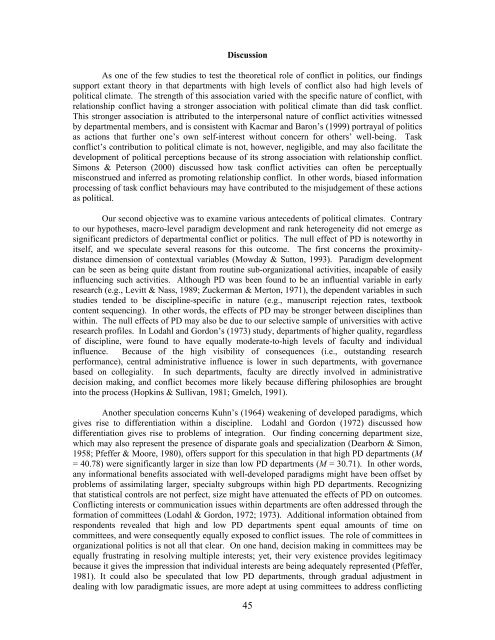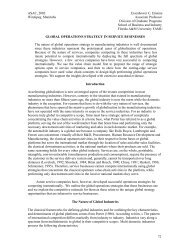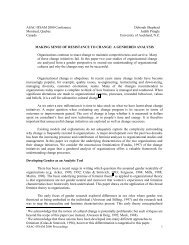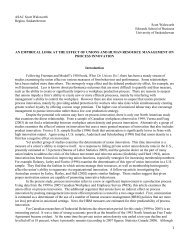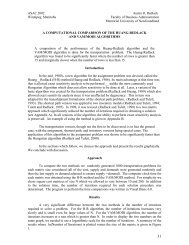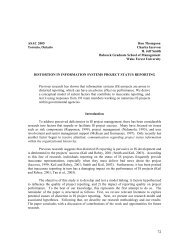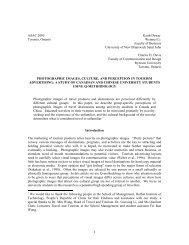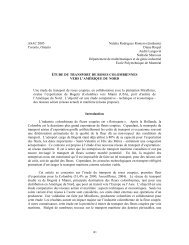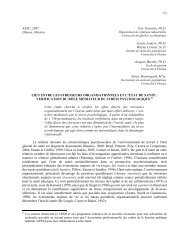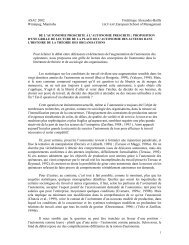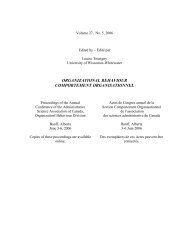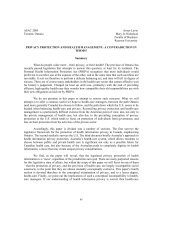Organizational Behaviour Comportement Organisationnel
Organizational Behaviour Comportement Organisationnel
Organizational Behaviour Comportement Organisationnel
Create successful ePaper yourself
Turn your PDF publications into a flip-book with our unique Google optimized e-Paper software.
DiscussionAs one of the few studies to test the theoretical role of conflict in politics, our findingssupport extant theory in that departments with high levels of conflict also had high levels ofpolitical climate. The strength of this association varied with the specific nature of conflict, withrelationship conflict having a stronger association with political climate than did task conflict.This stronger association is attributed to the interpersonal nature of conflict activities witnessedby departmental members, and is consistent with Kacmar and Baron’s (1999) portrayal of politicsas actions that further one’s own self-interest without concern for others’ well-being. Taskconflict’s contribution to political climate is not, however, negligible, and may also facilitate thedevelopment of political perceptions because of its strong association with relationship conflict.Simons & Peterson (2000) discussed how task conflict activities can often be perceptuallymisconstrued and inferred as promoting relationship conflict. In other words, biased informationprocessing of task conflict behaviours may have contributed to the misjudgement of these actionsas political.Our second objective was to examine various antecedents of political climates. Contraryto our hypotheses, macro-level paradigm development and rank heterogeneity did not emerge assignificant predictors of departmental conflict or politics. The null effect of PD is noteworthy initself, and we speculate several reasons for this outcome. The first concerns the proximitydistancedimension of contextual variables (Mowday & Sutton, 1993). Paradigm developmentcan be seen as being quite distant from routine sub-organizational activities, incapable of easilyinfluencing such activities. Although PD was been found to be an influential variable in earlyresearch (e.g., Levitt & Nass, 1989; Zuckerman & Merton, 1971), the dependent variables in suchstudies tended to be discipline-specific in nature (e.g., manuscript rejection rates, textbookcontent sequencing). In other words, the effects of PD may be stronger between disciplines thanwithin. The null effects of PD may also be due to our selective sample of universities with activeresearch profiles. In Lodahl and Gordon’s (1973) study, departments of higher quality, regardlessof discipline, were found to have equally moderate-to-high levels of faculty and individualinfluence. Because of the high visibility of consequences (i.e., outstanding researchperformance), central administrative influence is lower in such departments, with governancebased on collegiality. In such departments, faculty are directly involved in administrativedecision making, and conflict becomes more likely because differing philosophies are broughtinto the process (Hopkins & Sullivan, 1981; Gmelch, 1991).Another speculation concerns Kuhn’s (1964) weakening of developed paradigms, whichgives rise to differentiation within a discipline. Lodahl and Gordon (1972) discussed howdifferentiation gives rise to problems of integration. Our finding concerning department size,which may also represent the presence of disparate goals and specialization (Dearborn & Simon,1958; Pfeffer & Moore, 1980), offers support for this speculation in that high PD departments (M= 40.78) were significantly larger in size than low PD departments (M = 30.71). In other words,any informational benefits associated with well-developed paradigms might have been offset byproblems of assimilating larger, specialty subgroups within high PD departments. Recognizingthat statistical controls are not perfect, size might have attenuated the effects of PD on outcomes.Conflicting interests or communication issues within departments are often addressed through theformation of committees (Lodahl & Gordon, 1972; 1973). Additional information obtained fromrespondents revealed that high and low PD departments spent equal amounts of time oncommittees, and were consequently equally exposed to conflict issues. The role of committees inorganizational politics is not all that clear. On one hand, decision making in committees may beequally frustrating in resolving multiple interests; yet, their very existence provides legitimacybecause it gives the impression that individual interests are being adequately represented (Pfeffer,1981). It could also be speculated that low PD departments, through gradual adjustment indealing with low paradigmatic issues, are more adept at using committees to address conflicting45


